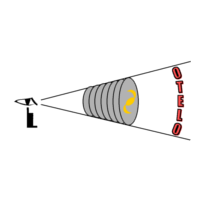OTELO - Ly-α emitters at z = 6
One of the great challenges of observational cosmology is to detect the ancestors of normal present day galaxies (like our Milky Way) in the early universe which are in the stage of their first star formation. The detection of a wide spread population of these primeval galaxies would provide us with detailed information about several aspects of galaxy formation and would put strong constrains for models of galaxy and structure formation in the universe.
One could expect that the spectrum of a primeval galaxy may have similar features as giant HII regions in nearby galaxies. On the other hand, it is possible to model the evolution of stellar populations in galaxies and the effects of intergalactic medium to predict spectral energy distributions of the high-redshift galaxies. Models predict that a young, dust-free, star-forming galaxy should show strong Ly-α emission with equivalent widths of 50-250 A. The flux in the Ly-α line should be 8-10 times stronger than H-α and proportional to the SFR. On the other hand, due to resonant scattering, Ly-alpha photons are absorbed by dust much heavily than continuum and Balmer photons. However, in the very first phase of star formation in galaxies, dust should not play a significant role implying that strong Ly-α emission is a criterion to select galaxies in the phase of forming their first generation of stars.
Many attempts have been made to search for strong emission-line sources at high-redshifts, although most of these searches have failed. Recently, new attempts with 10m-class telescopes, using narrow-band imaging methods,
See also: Related Publications
